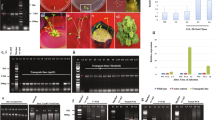Abstract
An in vitro screening procedure was adapted to study the sensitivity of callus to the toxin picolinic acid of Pyricularia grisea in four rice cultivars. The lethal dose LD50 was determined on the basis of probit-log dosage response curve. The values of LD50 were 10, 51, 129 and 151 ppm for Tetep, Newbonnet, Labelle and M 201, respectively. The callus culture of cultivar Tetep, with a known broad spectrum of resistance, exhibited a high toxin sensitivity whereas the highly susceptible cultivar M 201 showed low sensitivity indicating the absence of relation between host plant specific resistance to blast and resistance of the callus to toxin.
Similar content being viewed by others
References
Araujo LG (1994) —Variação somaclonal em arroz com relação a resistencia a brusone. Universidade Federal de Goiás, Goiânia. Tese Mestrado
Bouharmont J & Dekeyser A (1989) In vitro selection for cold and salt tolerance in rice. In: Mujeeb-Kazi A & Sitch L A (Eds) Review of Advances in Plant Biotechnology, 1985-88 (pp. 307–319). IRRI, Manila
Bouharmont J, Dekeyser A, Van Sint Jan VV & Dogbe YS (1991) Application of somalconal variation and in vitro selection to rice improvement. In: Rice Genetics II (pp 271–277). International Rice Research Institute, Manila
Brettell RIS & Ingram DS (1979) Tissue culture in the production of novel disease resistant crop plants. Biol. Rev. 54: 329–345
Cao J (1986) Improvement of rice through somaculture. PhD. thesis, Louisiana State University, Baton Rouge
Carlson PS (1973) Methionine sulfoximine-resistant mutants of tobacco. Science 180: 1366–1368
Croughan TP, Stavarek SJ & Rains DW(1981) In vitro development of salt resistant plants. Env. Exp. Bot. 21: 317–324
Daub ME (1986) Tissue culture and the selection of resistance to pathogens. Annu. Rev. Phytopathol. 24: 159–186
Finney DJ (1975) Statistical Methods in Biological Assay. Griffin, London
Gengenbach BG & Green CE (1975) Selection of T-cytoplasm maize callus cultures resistant to Helminthosporium maydis race T pathotoxin. Crop Sci. 15: 645–649
Helgeson JP & Deverall BJ (1983) Use of Tissue Culture and Protoplasts in Plant Pathology. Academic Press, New York
Ingram DS & Joachim I (1971) The growth of Peronospora farinosa f. sp. betae and sugarbeet callus tissues in dual culture. J. Gen. Microbiol. 69: 211–220
Kumashiro T (1983) Selection for tenuazonic acid tolerant cells of tobacco and characterstics of the regenerates. Japan. J. Breed. 33: 194-195
Larkin PJ & Scowcroft WR (1981) Somaclonal variation a novel source of variability from cell cultures for plant improvement. Theor. Appl. Genet. 60: 197–214
Ling DH, Vidhyasekharan P, Borremeo EDS, Zapata FJ & Mew TW (1985) In vitro screening of rice germplasm for resistance to brown spot disease using phytotoxin. Theor. Appl. Genet. 71: 133–135
Murashige T & Skoog F (1962) A revised medium for rapid growth and bioassy with tobacco tissue culture. Physiol. Plant. 15: 473–479
Reed SM & Rufty RC (1985) Reaction of calluses to blue mold resistant and susceptible Nicotiana genotypes to infection by Peronospora tabaciana. Tob. Sci. 29: 53–56
Rudolph K (1976) Non-specific toxins. In: Heitefuss R & Williams PH (eds) Encyclopedia of Plant Physiology. Vol 4 (pp 270–315). Springer Verlag, New York
Shepherd SLK (1990) —Selecção in vitro. In: Torres AC & Caldas LS (Eds) Técnicas e aplicaç ões de Cultura de Tecidos de Plantas, (pp 296–309). ABCTP/EMBRAPA-CNPH, Brasília
Tamari K, Ogasawara N & Kaji J (1965) Biochemical products of the metabolism of Pyricularia oryzae In: The Rice Blast Disease (pp 35–68). John Hopkins Press, Baltimore
Toenniessen GH(1990) Rice biotechnology: Progress and prospects. In: Pest Management in Rice (pp 514–536). Elsevier Applied Science, London
Uchiyama T & Ogasawa N (1977) Disappearence of cuticle and wax in outermost layer of callus cultures and decrease of protective ability against microorganisms. Agric. Biol. Chem. 41: 1401–1405
Uchiyama T, Sata J & Ogasawa N (1983) Lignification and qualitative changes in phenolic compounds in rice callus tissues inoculated with plant pathogenic fungi. Agric. Biol. Chem. 47: 1–10
Van Den Bulk RW (1991) Application of cell and tissue culture and in vitro selection for disease resistance breeding-a review. Euphytica 56: 269–285
Xie QJ, Rush MC & Cao J (1990) Somaclonal variation for disease resistance in rice (Oryza sativa L.) In: Pest Management in Rice (pp 491–509). Elsevier Applied Science, London
Yoder OC (1980) Toxins in pathogenesis. Annu. Rev. Phytopathol. 18: 103–129
Author information
Authors and Affiliations
Rights and permissions
About this article
Cite this article
Prabhu, A., Rush, M. Differential sensitivity of callus derived from immature panicles of rice cultivars to the non-specific toxin of Pyricularia grisea . Plant Cell, Tissue and Organ Culture 50, 13–18 (1997). https://doi.org/10.1023/A:1005854128836
Issue Date:
DOI: https://doi.org/10.1023/A:1005854128836




